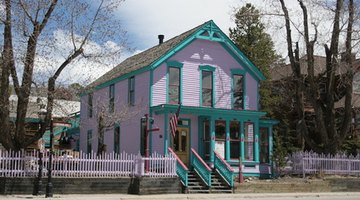Comparison of Brick to Hardiplank Siding
Table of Contents
There are both benefits and considerations offered by brick as well as Hardiplank siding. Hardiplank siding is fiber cement, a composite material made of sand, cement and cellulose fibers.

Some of the biggest selling points with both types of siding are that they are durable and require only slight maintenance throughout the years.
Features
The main material that is used in the construction of bricks for siding is clay, but a combination of clay and shale is also often used. Both brick and Hardiplank siding are available in a number of colors and styles. Hardiplank can be painted, but Home Tips recommends applying a primer coat first. Hardiplank siding is made with a beveled drip edge and can be manufactured out of several different species of wood, according to "This Old House."
Benefits
Both brick and Hardiplank siding offer consumers a number of benefits. Brick and Hardiplank are some of the most durable materials used in the construction of siding, but brick will outlast Hardiplank. Brick can survive the elements for well over 100 years before it begins showing signs of serious wear. According to Lucury Housing Trends, brick used for siding is exceptionally resistant to rot. Hardiplank offers only a mild degree of thermal and sound insulation, while brick offers very efficient thermal and sound insulation.
Considerations
Consumers should be aware that the company that manufactures Hardiplank siding offers two types of Hardiplank siding. One type is recommended for warm climates, while the other is recommended for colder climates. Silica dust can become airborne while handling Hardiplank siding; people should use dust masks while handling this type of siding. Brick, regardless of how durable it is, can crack under certain conditions. Professional masons have the skills needed to properly repair cracks in brick, stone and mortar, but their services are usually expensive. Improperly repaired cracks can lead to more damage throughout the years.
Installation
Brick siding can be painfully difficult to install without professional help, according to sources at Demesne. Hardiplank siding does not necessarily require the expert touch of a professional contractor. Handymen can install Hardiplank siding by positioning planks that overlap the planks below them by about 2 inches. They are nailed to the side of a house so that the following planks will overlap the nails below, keeping them out of sight.
Facts
The cost of installing brick is slightly offset by the fact that brick homes are linked with higher resale values than similar homes that feature most other types of siding. Luxury Housing Trends claims that consumers can expect to pay up to $12 per square foot of brick exterior. Hardiplank siding will only cost about $3 per square foot, according to Reality Times.
References
Photo Credits
- house image by Earl Robbins from Fotolia.com
- house image by Earl Robbins from Fotolia.com
More Articles


